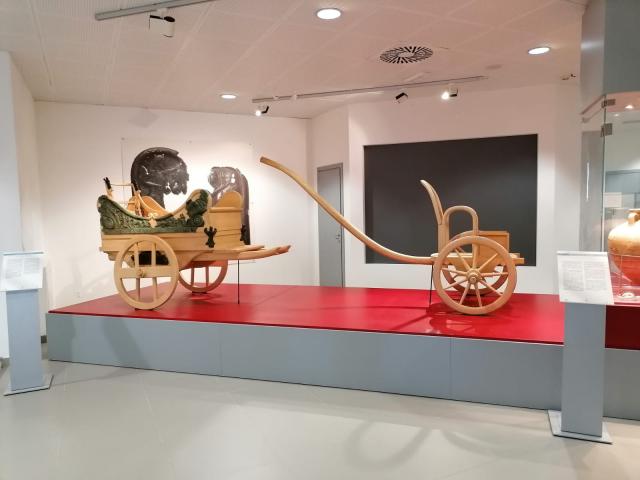Reconstruction of two princely chariots
Antiquarium

The bronze Chariots were found in April 1812 near Castel San Mariano, known in the scientific world as Streitwagen, the first of the two war chariots is dated 530-520 B.C. The vicissitudes of the fragments found in the excavation of 1812, narrated by Höckmann in 1982, are carefully reported in a recent study by Mafalda Cipollini of 2011, which offers an in-depth reconstruction of the two Etruscan bronze exhibits. The articulate vicissitudes that saw the material discovered in 1812 as protagonist, attest to the great dispersion suffered by the complex and by the components of the two bronze chariots.
At the time of the archaeological discovery, Giovanni Battista Vermiglioli, director of the museum of the University of Perugia, was unable to prevent more than a third of the materials from being dismembered, without logic, and appearing in European museums by means of antique markets. About 190 pieces and fragments arrived at the Perugia Museum. The remaining parts were appropriated by the art dealer Luigi Vescovali, who intervened at the time of discovery and had them restored. These 19th century restoration pieces ended up in Munich between 1966 and 1972. Instead, some pieces were sold to the Irish collector Edward Dodwell, who made casts, hypothetically for the collection of Leopoldo II at Palazzo Crocetta in Firenze. In 1825 Francesco Inghirami published drawings, perhaps taken from the casts of Florence or from the Dodwell bronzes which had passed through Florence between 1821 and 1826.
But, before 1815, Vescovali had sold, probably in Rome, other pieces that would later end up in London and Paris and to the numismatist James Millingen, then passing onto the collection of Richard Payne Knight and, in 1824, to the British Museum. Two fragments ended up in the Thorvaldsens Museum of Copenhagen: the Danish sculptor was in Rome until 1841, and managed to contact Vermiglioli. Once again Dodwell, in 1820, renounced selling his bronzes to the British Museum due to high custom costs, and sold nearly all of them to Prince Ludwig of Baviera, with the intermediation of the sculptor Martin von Wagner, Ludwig’s agent of art in Rome. In 1828, this group of objects became part of Staatliche Antikensammlungen of Monaco. Between 1827 and 1829 a statuette from the Dodwell collection ended up in the collection of Wilhelm von Dorow, and from there in 1831 to the Staatliche Museen of Berlin.
In 1819, another statuette was identified in France in the collection of Charles-Philippe Campion de Tersan, to then pass onto that of Edme-Antoine Durand and ending up at the Louvre in 1825. Yet another passed into the collection of Narcisse Révil and was purchased in 1835 by the Bibliothèque Nationale of Paris. In 1837, Dodwell’s heirs sold the remaining bronzes, along with other antiquities, to the Institute of Archaeological Correspondence in Rome. The list was drawn up by the general secretary of the Institute, and a Prussian envoy attached to the Vatican, Christian Karl Josias von Bunsen. Von Wagner made an appraisal based on Dodwell’s drawings. In 1939, all the antique pieces purchased by Ludwig I went to the Museum in Munich. Two fragments of the Dodwell collection finished up in that of Carolina Bonaparte, who arrived in Munich in 1841.
In 1848 the Bibliothèque Nationale of Paris acquired a lamina, coming from the “surrounding areas of Foligno”, but which corresponds exactly to one of the pieces of Perugia. The most famous piece is the carpentum, variously dated between 580 and 560 B.C., composed of four wheels, double shaft and a low curved side probably for animals in front. Among the reconstruction hypotheses, referring to the side of the structure the lamina figures a deer being attacked by lions, on the hole of which is a small lion protome in cast bronze. Some parts represent gods and mythological futures, variously attributed to the edges of a chest or sarcophagus (Minotaurs, 540 B.C.) or the back of the seat featuring a female figure and an archer, identifiable with Chimera and Hermes. The covering of one of the chariots is made up of a single parapet, probably decorated with the episode of Hercules and the Amazons; the lamina no longer retains its original bend that formed the sides; two fragments are lost.